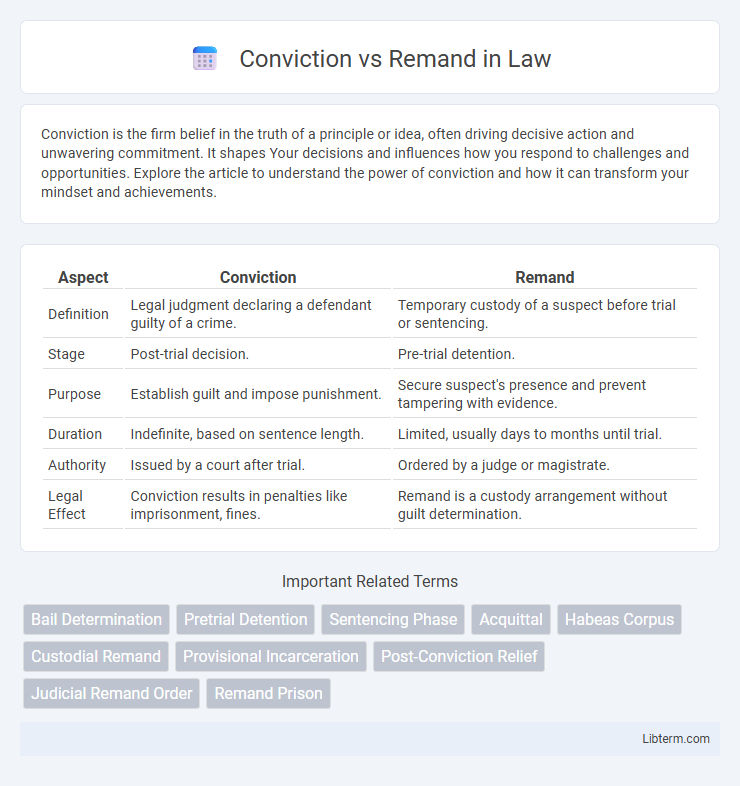Conviction is the firm belief in the truth of a principle or idea, often driving decisive action and unwavering commitment. It shapes Your decisions and influences how you respond to challenges and opportunities. Explore the article to understand the power of conviction and how it can transform your mindset and achievements.
Table of Comparison
| Aspect | Conviction | Remand |
|---|---|---|
| Definition | Legal judgment declaring a defendant guilty of a crime. | Temporary custody of a suspect before trial or sentencing. |
| Stage | Post-trial decision. | Pre-trial detention. |
| Purpose | Establish guilt and impose punishment. | Secure suspect's presence and prevent tampering with evidence. |
| Duration | Indefinite, based on sentence length. | Limited, usually days to months until trial. |
| Authority | Issued by a court after trial. | Ordered by a judge or magistrate. |
| Legal Effect | Conviction results in penalties like imprisonment, fines. | Remand is a custody arrangement without guilt determination. |
Understanding Conviction and Remand: Definitions
Conviction refers to the legal judgment that declares a defendant guilty of a crime following a trial or plea. Remand involves placing a defendant in custody while awaiting trial or further court proceedings, rather than issuing an immediate verdict. Understanding conviction and remand is essential for distinguishing between the final determination of guilt and temporary detention in the criminal justice process.
Legal Process: How Conviction Differs from Remand
Conviction signifies a formal legal judgment where a court finds a defendant guilty of a crime based on presented evidence. Remand refers to the judicial order to keep the accused in custody or under supervision while awaiting trial or further legal proceedings. The key difference lies in conviction concluding the trial with a verdict, whereas remand is a pre-trial measure ensuring the defendant's presence during the ongoing legal process.
The Stages of Criminal Proceedings
Conviction represents the stage in criminal proceedings where the accused is found guilty by the court after trial or plea, leading to sentencing. Remand occurs earlier, during pre-trial stages, where the accused is detained in custody pending trial or further investigation. Understanding these stages is crucial for grasping the procedural flow from arrest through court judgment in criminal justice systems.
Rights of the Accused: During Remand and After Conviction
Rights of the accused during remand include the right to legal counsel, protection from unlawful detention, and the presumption of innocence until proven guilty. After conviction, these rights shift toward the right to appeal, access to fair sentencing, and humane treatment while serving the sentence. Maintaining these rights throughout both stages safeguards the accused from abuses and ensures due process under the law.
Grounds for Remand: When Is It Applied?
Grounds for remand commonly include procedural errors, new evidence discovery, or ineffective assistance of counsel that could impact the trial's fairness. Remand is applied when the appellate court finds that these substantial issues require the case to be reconsidered or retried to uphold justice. This process ensures correction of trial court mistakes without affirming conviction prematurely.
Consequences and Implications of Conviction
A conviction results in a formal declaration of guilt, leading to consequences such as sentencing, criminal record, and potential loss of civil rights. It can affect future employment opportunities, eligibility for housing, and increase difficulty in obtaining certain licenses or professional certifications. Conviction also influences parole eligibility, probation conditions, and may result in long-term social stigma and legal disabilities.
Bail and Remand: Key Differences
Bail allows an accused person to be temporarily released from custody until trial by providing a financial guarantee or surety, whereas remand involves the accused being held in custody while awaiting trial or further investigation. Bail decisions consider factors such as flight risk, risk of tampering with evidence, and public safety, while remand is ordered when these risks are deemed high or bail conditions cannot mitigate them. Courts use bail and remand differently to balance the presumption of innocence with ensuring the accused appears for trial and does not interfere with the judicial process.
Duration: How Long Can Remand Last Versus a Sentence After Conviction?
Remand duration varies widely depending on legal system and case complexity, often lasting from a few weeks to several months, but can extend up to years in certain jurisdictions. After conviction, sentences are predetermined by statute or judge's ruling, ranging from days to life imprisonment, with some offenses mandating minimum or maximum terms. Remand is a temporary measure before trial or sentencing, whereas conviction results in a fixed, enforceable sentence.
Impact on the Individual: Psychological and Social Aspects
Conviction often results in long-term psychological effects such as shame, anxiety, and loss of self-esteem, significantly altering an individual's social identity and community relationships. Remand, involving pre-trial detention, can cause acute stress, uncertainty, and social isolation due to disrupted family ties and employment instability. Both states negatively impact mental health, but conviction frequently leads to prolonged stigmatization and barriers to reintegration into society.
Conviction vs Remand: Legal Remedies and Appeals
Conviction refers to the formal declaration by a court that a defendant is guilty of a criminal offense, often resulting in sentencing or penalties, while remand involves the temporary detention of an accused person pending trial or further investigation. Legal remedies for conviction primarily include appeals aimed at overturning the verdict, reducing sentences, or seeking retrials based on procedural errors or new evidence. In contrast, remand decisions can be challenged through bail applications or habeas corpus petitions to ensure lawful detention and protect individual rights during pre-trial proceedings.
Conviction Infographic

 libterm.com
libterm.com